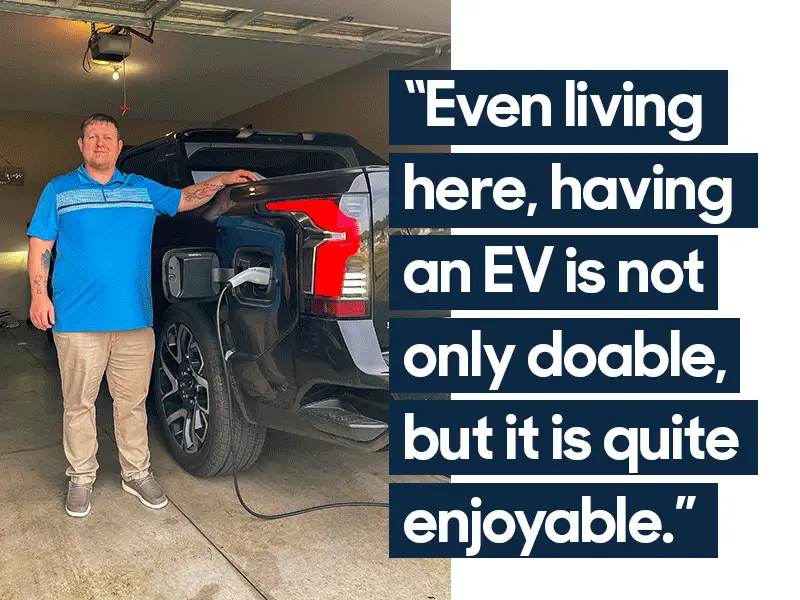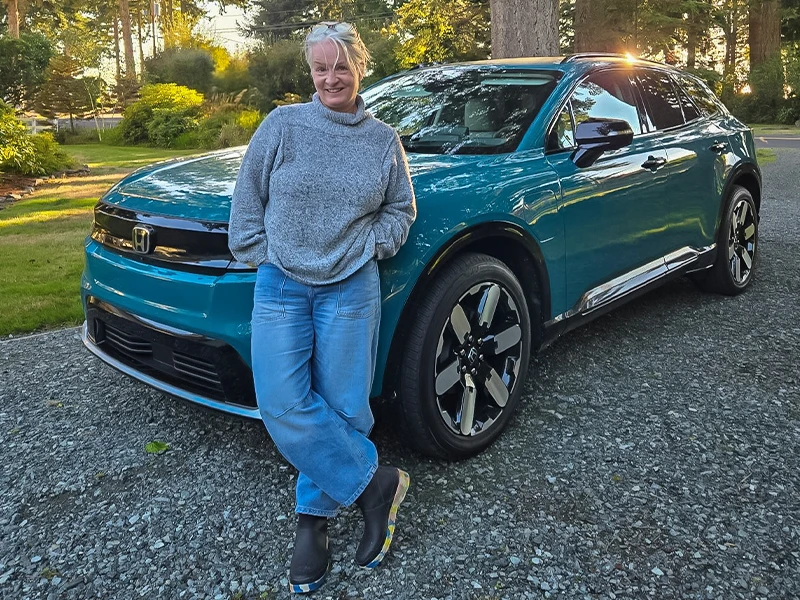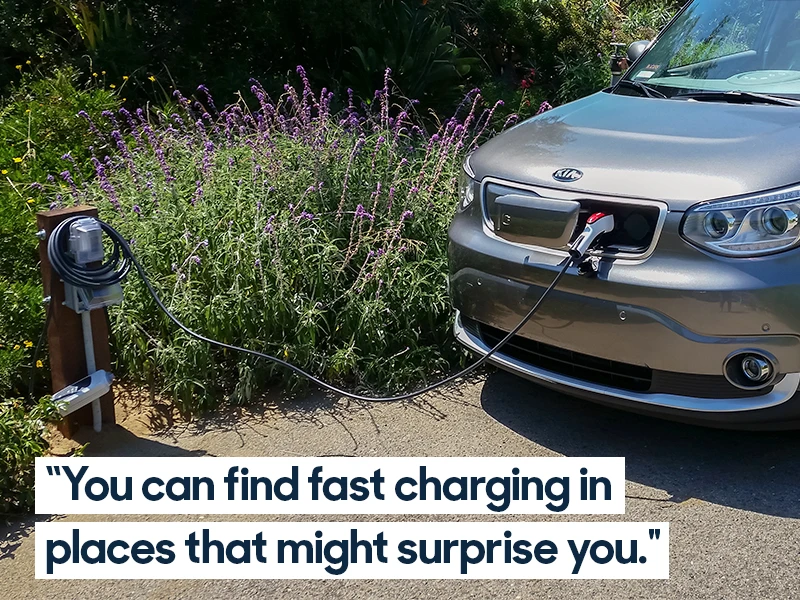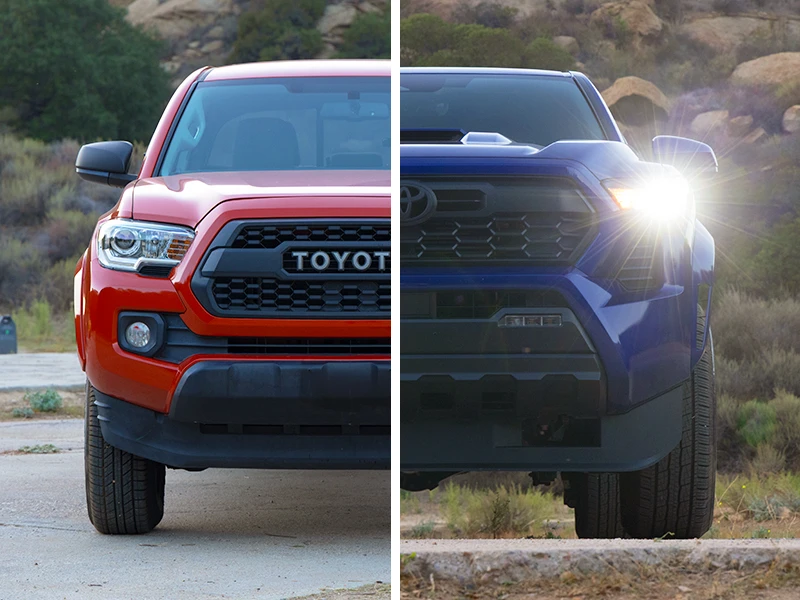Despite living in rural Wisconsin, Jeremiah Brockman and his wife rely on electric vehicles for their commutes and even for trimming the lawn. In 2021, Brockman and his wife bought a 2021 Tesla Model Y Long Range. After driving that for three years, they were so confident in electric vehicles that they purchased a 2024 Chevy Silverado EV in August this year.
Brockman has become an EV enthusiast. He’s now the president of the Wisconsin Electric Vehicle Association and always takes time to show other rural residents that driving and charging an EV in rural areas is just as practical for them as it is for people in a city.

“Even living here, having an EV is not only doable, but it is quite enjoyable,” he says.
People in rural areas generally drive further than their urban and suburban counterparts and often have fewer EV chargers nearby. Worries over range anxiety and charging availability may explain why adoption of EVs is 40% lower in rural areas than in cities. And yet, there are still some rural EV drivers who say they’ve had no trouble going electric.
Alyssa Royse lives in Seattle, but regularly commutes 120 miles to her cabin on the Olympic Peninsula, where she stays for long stretches at a time. She bought a 2015 Nissan Leaf in 2017 as an “experiment,” and enjoyed it so much that she and her husband bought a 2024 Honda Prologue this summer.
Joey Racano, who lives in rural coastal California, has been driving a 2016 Kia Soul EV that he bought new and said he has no problem zipping around gas-free. Now, he's awaiting delivery of a 2024 Tesla Cybertruck.
Here, a few drivers share eight tips that have helped them convert to EVs while living in a rural area.
1. Calculate the range you need
The biggest concern for many rural drivers is range. Although EV ranges are increasing, not all cars are created equal. When you’re considering an EV, think about your daily and weekly driving habits, and how range limits might impact those. Ultimately, that might help you decide which EV is the right choice for you.
“We decided to buy a Chevy Silverado EV over the Ford F-150 Lightning," says Brockman, because when new “the Silverado has about 120 more miles of EPA-estimated range per charge. If you have to do a lot of driving one day, that difference makes life much easier.
2. Consider which chargers are available
The availability of electric vehicle charging stations is another big consideration, especially since the majority of charging infrastructure is concentrated in cities and along major highways. Talk to other EV owners about how they charge, and find out what networks are available close by. Brockman knew that Tesla had a supercharger in his town and was aware that the brand had a widespread charging network. This is why he decided to buy a Tesla as his first EV.
3. Plan your home EV charging station

Most EV drivers charge up for daily driving while they’re at home, since it can work out well for your wallet —but you need the right setup. Last year, Royse had a Level 2 EV charger (a 240-volt fast charger) installed at her cabin before she bought her second EV.
“The peace of mind is invaluable, but it also pays for itself fairly quickly,” she says.
Racano charges his Kia in his driveway, using a charger plugged into a Tesla Powerwall home battery, which stores electricity generated by his rooftop solar array. That's important to his goal of energy autonomy since it allows him to charge his vehicle without relying on the grid, he said.
Brockman installed two 240-volt fast chargers in his garage so he can plug his vehicles in overnight. “Every morning when we wake up, the car is "full" and ready for us to do our driving for the day,” he says.
He notes that you don’t have to have a home charging station to charge. Even people in apartments can charge using a 120-volt, three-prong outlet. The charging time will be much slower, however. EVs will gain, on average, five miles of range for each hour the vehicle is plugged into a 120-volt outlet. Even so, for most people the charge acquired overnight will be enough to handle daily driving—even in frigid winter temps when range can be diminished, he said.
“Basically, if you have electricity where you live, you have a place to charge your car,” Brockman explains.
Learn more: What is EV fast charging?
4. Utilize rebates and grants
If you’re installing a home [SB6] EV charging station, ask your utility company or state Department of Environmental Services if they offer any monetary support.
“In many cases, there are rebates or grants out there that will help you pay for the cost of installing EV charging equipment,” Brockman says.
While you're looking into this, be sure to check out tax credits available for purchasing an EV.
5. Plan your route using apps
Racano is a musician who sometimes has to travel longer distances for gigs. Sometimes, he tows his Kia behind his motor home. If he’s driving the EV, he plans those trips out so he knows exactly where to stop for a charge—and to give himself a break from driving.
“It becomes second nature,” he says. “Instead of stopping at the gas station, you hook up to charge the car, grab lunch, use the restroom, and maybe do light shopping or walking. The car and you are ready at the same time!”
Brockman and Royse both use the app PlugShare to locate chargers for longer trips. Royse has also learned that Walmart locations will often have chargers in their parking lots.
6. Always have a backup plan
While it’s helpful to know where chargers are, Royse has learned to never fully count on chargers being available. Instead, she always retains enough charge so that she’s not at risk of running out of battery.
“You could pull up, low on charge, and find out it’s not working. It’s not like you can just go to the next exit and know there will be one,” she says.

She’s also developed another backup plan: using RV parks to charge. RV outlets are generally 30- or 50-amp outlets, and 110 or 220 volts. The increased amperage and voltage result in faster charging.
"Then you can find fast charging in places that might surprise you," Royse says.
Learn more: What Happens When an Electric Car Battery Runs Out of Charge?
7. Adjust your driving habits
After years of driving an EV, Racano has noticed that his behavior behind the wheel makes a big difference in how much range he gets. (It's one of many ways to improve the real-world range of your EV).
“Drive slow and steady,” he says. "It conserves the battery.”
8. Connect with other EV drivers
Since there can be misconceptions about making the switch to an EV, connecting with experts and other drivers is important. Brockman often directs people to the following resources:
“These are doing great work educating people about EVs, affecting policy, and making the transition to EVs smoother,” he adds.
You can also visit CarMax's EV Hub for more information on how to find the right electric car for you, as well as information on EV financing.
EV Success in Rural Areas
Not only are EVs easy to operate in rural areas—they’re also fun. “What I wish I knew before I went EV, is just how much more responsive these electrics are, as compared to gasoline cars,” said Racano.
Royse agrees and says the savings of going electric are nice, too. “They’re super zippy to drive because there are no traditional gears to go through, and we quickly got hooked on not having to buy gas. When you factor in that there’s less routine maintenance besides tires and wiper blades, that can be big savings in terms of the cost of car ownership.”
Our series, Switching to EV, covers first-hand experiences from seasoned EV owners. We explore the details of EV ownership—what it's like to charge, adjusting to battery range, maintenance costs, pros, cons, and more.
Learn more with these stories:




